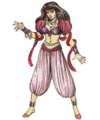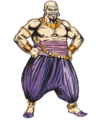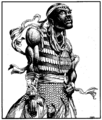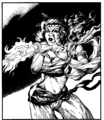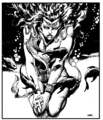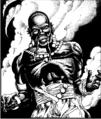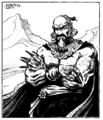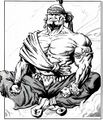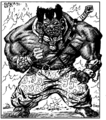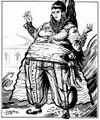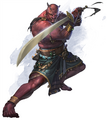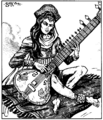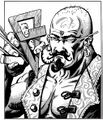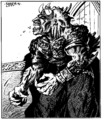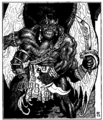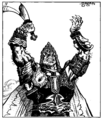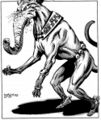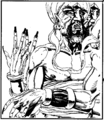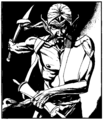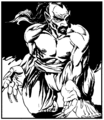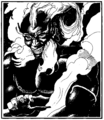Genie: Difference between revisions
No edit summary |
m (56 revisions imported) |
||
| (45 intermediate revisions by 18 users not shown) | |||
| Line 1: | Line 1: | ||
Genies, a term corrupted from the | {{Topquote|I'm in the mood to help you dude, you ain't never had a friend like me!|The Genie}} | ||
[[File:genie alladin.png|thumb|Fig. 1: A genie.]] | |||
'''Genies''', a term corrupted from the Arabic term "[[djinn]]" (جن), are mystical spirits originating from Arabic folklore and later getting incorporated into the religion of Islam as something of a grey area between an equivalent to Christian [[demons]] and simply another race of mortals. They are best known for their immense magical powers, which iconically allow them to literally alter reality as they see fit. Because of this, mages have a pretty long tradition of magically stuffing them into small objects (lamps are most iconic, but rings and vases are pretty common too) and compelling them to obey whoever holds their prison. They also tend to be [[Eldrad|major league dicks]], though whether they are dicks due to being magically enslaved or enslaved for being dicks tends to vary. | |||
The most common stories involving Genies involve someone setting one free and in return allowing them wishes, generally with a certain amount of mischief in creative interpretation. You rub a bottle, a genie comes out, make a wish and you end up running for your life from a 30 meter tall Nixon as he rampages through your hometown Kaiju Style. Worth noting is that the wish-granting worked very different in the original tales than it does in modern fantasy, in several ways: 1)The number of wishes a given genie offered was not necessarily three; depending on the genie, it could be one wish, infinite wishes, or any number in between. 2) The actual granting of a wish didn't consist of the genie snapping their fingers and magicking your desires into reality, it was just them doing a favor they owed you by mundane means; if for example you wished to be the king/queen of the land, the genie would do something like go and purchase the title from the current ruler. 2i) As such, there was no guarantee that the genie would be able to grant your wish. Genies varied significantly in how powerful they were: one might be able to afford the purchasing of the queen's crown, for example, but another might only be able to get you as high as a baroness. 3) They were not a wish machine per se - they granted wishes out of genuine gratitude for being freed or because they swore an oath (implied to be on God's name, and thus with severe punishment for breaking) to do so [in one case he swore to kill the one who freed him for taking so long (due to having spend so long in the bottle that he went mad), and had to be tricked into the oath first], while the spirit of the lamp was a slave, impisoned by a powerful sorcerer in the past. | |||
They're usually pretty good looking, and it's not unheard of for them to have sex with or even marry mortals. | They're usually pretty good looking, and it's not unheard of for them to have sex with or even marry mortals. | ||
=[[Dungeons & Dragons]]= | |||
[[File:Female Efreet PF.jpg|thumb|right|300px|A Pathfinder take on the Efreet.]] | [[File:Female Efreet PF.jpg|thumb|right|300px|A Pathfinder take on the Efreet.]] | ||
Genies are one of the "big names" for the [[Elemental Planes]]; being the most human-like in appearance and intelligence, they present a "face" for interactions both positive and negative that the more primordial elementals lack. There are four species of genie, one for each of the four major elements | Genies are one of the "big names" for the [[Elemental Planes]]; being the most human-like in appearance and intelligence, they present a "face" for interactions both positive and negative that the more primordial elementals lack. There are four species of genie, one for each of the four major elements: [[Djinn]] (air), [[Efreet]] (fire), [[Dao]] (earth), and [[Marid]] (water); some editions also have a fifth, the [[Jann]], comprised of all four elements and thus needing to spend most of their time on the Prime Material. Although very different in personality, the various types each share certain traits, including polyamory (except the Jann) and large libidos, vaguely Middle Eastern cultures, and the ability to grant wishes with a laundry list of restrictions (notably, they can't grant wishes for themselves or other genies, and while they can grant one wish a day they can't grant another wish to the ''same'' creature until a very long period of time has passed). | ||
Of these four (to five) races, it has always been the Djinn and the Efreet who have stuck out the most in the D&D player's mind. These two races have very clear archetypes; djinni are the "friendly leaning but dangerous if made moody" genies, whilst efreeti are the "obviously evil genies". In comparison, dao tend to boil down to "efreeti with earth powers and a lot more greed for gold and gems", whilst marids tend to boil down to "djinni with water powers, an even more fickle attitude, and a barrowload of extra ego". Jann, being both the weakest type of genie and the one type native to the Prime Material and thus more likely to be met in person on your travels than found in a magic item, come across more as a race of desert nomads with magic than "proper" genies. | |||
In fact, it got to the point that 4e originally left those three races out; it wasn't until an article in [[Dungeon Magazine]] #199 that the dao and marids both returned to 4th edition (the Jann could suck it). And they were still pretty much identical to their classic depictions; dao were avaricious, evil, giant earth-genies obsessed with mineral wealth, and marids were arrogant, flamboyant, adventurous water genies who all to the last claimed a noble title. Whether this was deliberate - a lot of the later 4e Dungeon & Dragon magazine articles tended towards bringing back older lore - or was just a sign that the grid-filling nature of D&D genies robs even the best authors of their creativity, who can say? | |||
[[Al-Qadim]], the "Arabian Nights" mini-setting for the [[Forgotten Realms]], placed a lot of emphasis on genies, naturally. It created the "[[Tasked Genie]]" designation, a variety of lesser genies specially molded to fulfill certain tasks until they had become entirely new species revolving around that task (specific strains: Administrator, Architect/Builder, Artist, Deceiver, Guardian, Harim Servant, Herdsman, Messenger, Miner, Oathbinder, Slayer, Warmonger and Winemaker). It created the [[Markeen]], or "Genie Double", a genie cursed to be the exact physical replica of a mortal, and it introduced the [[Sha'ir]] class; a [[Wizard]] variant that drew its powers from the service of a minor allied genie called a gen. | |||
Genies are one of the elementals most likely to produce [[genasi]] offspring, though [[Pathfinder]] also has a specific "genie-born" hybrid, the [[Suli]]. | |||
3.5's Tome of Magic introduced a new breed of genie; the [[Khayal]], a "darkness elemental" genie native to the [[Plane of Shadow]]. Master wielders of shadow magic, khayal are distinguished by their dark, dusky-gray skin and their utter-black eyes, which appear more like night-filled holes in their skull than anything human-like. If one can look past that, they otherwise look like slightly taller than average humans. They regard the other elemental genies with varying levels of antipathy, but have an especial hatred for jann. Looking down on all other races, khayal culture revolves around deciving and manipulating them - although they are never anything but scrupulously honest with each other. Tradition holds that anyone who can irrefutably prove they have been lied to by a khayal is owed a single task from that genie in recompense, but they don't always live up to this. They have been known to assist mortals of their own volition, either out of mutual need or due to being impressed at the mortal's deceitfulness, but they display archetypical genie arrogance when they do. | |||
3.5 also gave us the Frostfell sourcebook, and with it, the [[Qorrashi]], who were associated with the Paraelemental Plane of Ice, but they only got an average-size soucebook bestiary-level description, so there's not much to say about them other than that they exist. | |||
==Gallery== | |||
<gallery> | |||
2e Dao (MM).gif|2e Dao | |||
2e Djinni (MM).gif|2e Djinni | |||
efreeti MM 2e.png|2e efreeti | |||
marid MM 2e.png|2e marid | |||
2e Dao Female (LoF).png|2e Female Dao | |||
2e Djinni Female (LoF).png|2e Female Djinni | |||
2e Efreet Female (LoF).png|2e Female Efreet | |||
2e Marid Female (LoF).png|2e Female Marid | |||
2e Dao Male (LoF).png | |||
2e Djinni Male (LoF).png | |||
2e Efreet Male (LoF).png | |||
2e Marid Male (LoF).png | |||
2e Janni Female (LoF).png | |||
2e Janni Male (LoF).png | |||
noble dao MC Al-Qadim.png|Noble Dao | |||
noble djinn MC Al-Qadim.jpg|Noble Djinni | |||
noble efreet MC Al-Qadim.png|Noble Efreeti | |||
noble marid MC Al-Qadim.jpg|Noble Marid | |||
Djinn & Efreeti 3E.jpg|3e Djinn & Efreeti | |||
3e Dao and Marid.png|3e Dao and Marid | |||
Qorrashi.jpg|Qorrashi | |||
Khayal.jpg|Khayal | |||
4e Dao.png|4e Dao | |||
4e Marid.png|4e Marid | |||
4e Djinn Skylord.png|4e Djinn | |||
4e Djinn Stormsword.png | |||
4e Djinn Thunderer.png | |||
4e Djinn Windbow.png | |||
4e Efreeti.png|4e Efreeti | |||
4e Efreet Sultan of Brass.png|4e Efreeti Sultan of Brass | |||
Dao-5e.png|5e Dao | |||
Djinn5E.PNG.png|5e Djinn | |||
Efreeti-5e.png|5e Efreeti | |||
Marid-5e.jpg|5e Marid | |||
</gallery> | |||
===Tasked Genies=== | |||
<gallery> | |||
artist genie MC Al-Qadim.png|Artist Genie | |||
builder genie MC Al-Qadim.jpg|Builder Genie | |||
guardian genie MC Al-Qadim.png|Guardian Genie | |||
herdsman genie MC Al-Qadim.jpg|Herdsman Genie | |||
slayer genie MC Al-Qadim.png|Slayer Genie | |||
warmonger genie MC Al-Qadim.png|Warmonger Genie | |||
winemaker genie MC Al-Qadim.jpg|Winemaker Genie | |||
administrator genie City of Delights.png|Administrator Genie | |||
administrator genie MCAV1.jpg | |||
deceiver genie ALQ2.png|Deceiver Genie | |||
deceiver genie MCAV1.jpg | |||
harim servant genie City of Delights.png|Harim Servant Genie | |||
harim servant genie MCAV1.jpg | |||
messenger genie ALQ4.png|Messenger Genie | |||
messenger genie MCAV1.jpg | |||
miner genie ALQ4.png|Miner Genie | |||
miner genie MCAV1.jpg | |||
oathbinder genie ALQ2.png|Oathbinder Genie | |||
oathbinder genie MCAV1.jpg | |||
</gallery> | |||
Genies | =Pathfinder= | ||
{{stub}} | |||
[[File:Pathfinder Genies.jpg|thumb|right|250px|The complete line-up of [[Golarion]] Genies.]] | |||
Mostly identical to the classic D&D version, complete with dividing its genies into four elemental types. They call their earth genies "Shaitan", though. | |||
{{clear}} | |||
=[[Changeling: The Lost]]= | |||
It's quite possible for a [[changeling]] - or, more fittingly, a True Fae - in [[Changeling: The Lost]] to style themselves after a genie. In fact, the splat ''Night Horrors: Grim Fears'' actually features a genie-motifed magically bound True Fae called Ybalashi, who is compelled to grant the wishes of whoever holds her vessel. Of course, as her title of "The Artisan of Poisoned Desires" suggests, making use of her magic isn't a smart thing to do. | It's quite possible for a [[changeling]] - or, more fittingly, a True Fae - in [[Changeling: The Lost]] to style themselves after a genie. In fact, the splat ''Night Horrors: Grim Fears'' actually features a genie-motifed magically bound True Fae called Ybalashi, who is compelled to grant the wishes of whoever holds her vessel. Of course, as her title of "The Artisan of Poisoned Desires" suggests, making use of her magic isn't a smart thing to do. | ||
=[[Warhammer Fantasy]]= | |||
[[File:Djinn warmaster.webp|thumb]] | |||
[[File:Djinn dreadfleet.webp|thumb|left|Arabyan ship from Dreadfleet powered by Djinn]] | |||
The presence of genies in [[Warhammer Fantasy Battles]] is one of those... "wiggly" areas. They ''do'' canonically exist, but the problem is that they are exclusively associated with [[Araby]]... which started out weak in the oldest iterations of the setting and steadily declined to mere cameos in the lore of other factions. | |||
What little is known about them is that they are [[elemental]] beings found in [[Araby]], whose local wizards use enchanted vessels to bind them to their will and command them in battle. Genies appear in the [[Warmaster]] gaiden game as an Araby unit, whilst [[Dreadfleet]] features one of the last ever canonical appearances of a genie in the form of Arabyan special character, [[The Golden Magus]], whose ship is visibly attended by two huge genies: one of fire preparing to attack an unseen enemy ship, and one of clouds and wind propelling the Magus' ship with its mighty breath. | |||
Most WFB lore instead likes to use the [[Lord of Change]], the Greater [[Daemon]] of [[Tzeentch]], in a role akin to the traditional asshole genie. For example, in one old Warhammer comic, an imprisoned [[Lord of Change]] was set free by three travelers. In "appreciation" for them setting it free, he would each give them a wish. The first wanted the ability to fly, and the Daemon turned him into a fly. When the two complained, it defended itself by claiming that he wasn't specific enough. So the second wished to live forever, and the daemon turned him into a vampire, which then forced the third companion, a Dwarf, to kill him. The dwarf, seeing that the Lord of Change would obviously screw over any wish it will grant, would then wish for the daemon to be imprisoned once again... if he were actually intelligent! [[Derp|Instead the dwarf had the brilliant decision of making a wish that he was worth his weight in gold]], [[FAIL|which worked just as about as well as you might expect since the daemon then turns him into a statue of solid gold.]] Meanwhile, over in [[Mordheim]], the mercenary Nicodemus was a wizard's apprentice who foolishly freed a bounded Lord of Change and then wished to be "the greatest wizard in the world". This caused him to start growing into a giant spellcaster, and he was forced to come to Mordheim for a steady supply of the wyrdstone he needs in his growth-retardant potion. There's even a fan adventure where he runs out of potion long enough to grow to the size of a ''real'' giant. | |||
===WAP=== | |||
Naturally, the [[Warhammer Army Project]] went ahead and added genies in its depiction of a Warhammer Armies: Araby book. And unlike the Asuras from the [[Kingdoms of Ind]], they didn't just take [[daemon]]s and call it a day. Instead, they decided that since [[Warhammer Fantasy Battles]] was largely born out of [[Games Workshop]] ripping off [[Dungeons & Dragons]], they'd go back to those roots and they shamelessly stole the D&D genie list to pad out their basic reiteration of [[Oldhammer]] genie lore. | |||
All Genies have the special rules Monstrous Infantry, Magical Attacks, Unstable, and Ward Save (5+). They also have the special rule "Genie Binding", which means that rather than taking up a character slot in their own right, you ''must'' have a Sorcerer or Sorcerer Lord in your army as well, representing the [[wizard]]s who bring them into battle - a regular Sorcerer can bind one genie, and a Sorcerer Lord can bind two genies, at a cost of 95 points per genie. They don't start play openly, but instead their associated sorcerer can attempt to summon them by passing a Leadership test; on the plus side, you can resummon a "killed" genie as often as you like (save for that pesky cumulating -1 LD penalty for each time the genie was slain), but on the down side, if the sorcerer dies, the genie is immediately considered a casualty too! | |||
[[Dao]] are malicious genies tied to the element of earth, resembling powerfully muscled humanoids with earthen, sand or granite-colored skin and pudgy-fingered hands whose nails are made of lustrous metal. They're characterized as the simplest and most brutish of the genies, often cozened into service, but also renowned as the toughest. They have Movement 6, Weapon Skill 5, Ballistic Skill 3, Strength 4, Toughness 5, Wounds 3, Initiative 4, Attacks 3, and Leadership 7. They have Natural Armor (4+), and can cast Flesh to Stone (Lore of Life) as an innate Bound Spell, power level 5. | |||
[[Marid]]s are water genies, towering and beautriful, with ocean-colored skin that changes tone to reflect their mood, darkening as they grow angrier. Most have blue-black or dark grey hair, but watch out if you get a seafoam-white haired marid, because they are exceptionally strong-willed, independent and chaotic in temperament. Their particular talent is in absorbing and dispelling magic. They have Movement 6, Weapon Skill 5, Ballistic Skill 3, Strength 4, Toughness 4, Wounds 3, Initiative 5, Attacks 4, and Leadership 7. They have Magic Resistance (2), Immunity (Ice Attacks) and can cast Iceshard Blizzard (Lore of Heavens) as an innate Bound Spell, power level 4. | |||
[[Djinn]] are proud and sensuous genies of air, appearing as tall, noble-featured, well-muscled humans, who may have mundane Arabyan coloration or pale blue skin. Blue-eyed djinn are believed to be marked by fate for great actions. They have Movement 6, Weapon Skill 5, Ballistic Skill 3, Strength 4, Toughness 4, Wounds 3, Initiative 6, Attacks 3, and Leadership 7. They have Fly 10 and can cast Wind Blast (Lore of Heavens) as an innate Bound Spell, power level 4. | |||
[[Efreet]] are fire genies, and renowned as the most angry, vicious, and temperamental of all the genies, unless they manipulated by flattery or realize their summoner is legitimately more powerful than they are. Their physical description is literally just ripped straight from the pages of D&D. They have Movement 6, Weapon Skill 5, Ballistic Skill 3, Strength 5, Toughness 4, Wounds 3, Initiative 5, Attacks 3, and Leadership 7. They have Hatred, Flaming Attacks, Immunity (Flaming Attacks) and can cast Flaming Sword of Rhuin (Lore of Fire) as an innate Bound Spell, power level 5. | |||
{{D&D-Outsiders}} | |||
Latest revision as of 09:08, 21 June 2023
"I'm in the mood to help you dude, you ain't never had a friend like me!"
- – The Genie
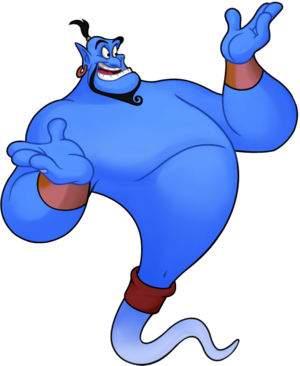
Genies, a term corrupted from the Arabic term "djinn" (جن), are mystical spirits originating from Arabic folklore and later getting incorporated into the religion of Islam as something of a grey area between an equivalent to Christian demons and simply another race of mortals. They are best known for their immense magical powers, which iconically allow them to literally alter reality as they see fit. Because of this, mages have a pretty long tradition of magically stuffing them into small objects (lamps are most iconic, but rings and vases are pretty common too) and compelling them to obey whoever holds their prison. They also tend to be major league dicks, though whether they are dicks due to being magically enslaved or enslaved for being dicks tends to vary.
The most common stories involving Genies involve someone setting one free and in return allowing them wishes, generally with a certain amount of mischief in creative interpretation. You rub a bottle, a genie comes out, make a wish and you end up running for your life from a 30 meter tall Nixon as he rampages through your hometown Kaiju Style. Worth noting is that the wish-granting worked very different in the original tales than it does in modern fantasy, in several ways: 1)The number of wishes a given genie offered was not necessarily three; depending on the genie, it could be one wish, infinite wishes, or any number in between. 2) The actual granting of a wish didn't consist of the genie snapping their fingers and magicking your desires into reality, it was just them doing a favor they owed you by mundane means; if for example you wished to be the king/queen of the land, the genie would do something like go and purchase the title from the current ruler. 2i) As such, there was no guarantee that the genie would be able to grant your wish. Genies varied significantly in how powerful they were: one might be able to afford the purchasing of the queen's crown, for example, but another might only be able to get you as high as a baroness. 3) They were not a wish machine per se - they granted wishes out of genuine gratitude for being freed or because they swore an oath (implied to be on God's name, and thus with severe punishment for breaking) to do so [in one case he swore to kill the one who freed him for taking so long (due to having spend so long in the bottle that he went mad), and had to be tricked into the oath first], while the spirit of the lamp was a slave, impisoned by a powerful sorcerer in the past.
They're usually pretty good looking, and it's not unheard of for them to have sex with or even marry mortals.
Dungeons & Dragons[edit]
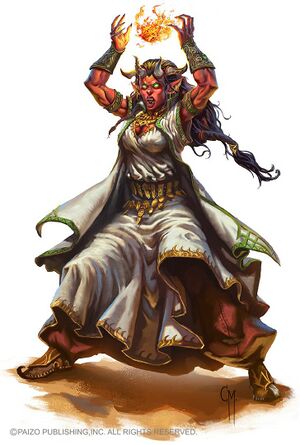
Genies are one of the "big names" for the Elemental Planes; being the most human-like in appearance and intelligence, they present a "face" for interactions both positive and negative that the more primordial elementals lack. There are four species of genie, one for each of the four major elements: Djinn (air), Efreet (fire), Dao (earth), and Marid (water); some editions also have a fifth, the Jann, comprised of all four elements and thus needing to spend most of their time on the Prime Material. Although very different in personality, the various types each share certain traits, including polyamory (except the Jann) and large libidos, vaguely Middle Eastern cultures, and the ability to grant wishes with a laundry list of restrictions (notably, they can't grant wishes for themselves or other genies, and while they can grant one wish a day they can't grant another wish to the same creature until a very long period of time has passed).
Of these four (to five) races, it has always been the Djinn and the Efreet who have stuck out the most in the D&D player's mind. These two races have very clear archetypes; djinni are the "friendly leaning but dangerous if made moody" genies, whilst efreeti are the "obviously evil genies". In comparison, dao tend to boil down to "efreeti with earth powers and a lot more greed for gold and gems", whilst marids tend to boil down to "djinni with water powers, an even more fickle attitude, and a barrowload of extra ego". Jann, being both the weakest type of genie and the one type native to the Prime Material and thus more likely to be met in person on your travels than found in a magic item, come across more as a race of desert nomads with magic than "proper" genies.
In fact, it got to the point that 4e originally left those three races out; it wasn't until an article in Dungeon Magazine #199 that the dao and marids both returned to 4th edition (the Jann could suck it). And they were still pretty much identical to their classic depictions; dao were avaricious, evil, giant earth-genies obsessed with mineral wealth, and marids were arrogant, flamboyant, adventurous water genies who all to the last claimed a noble title. Whether this was deliberate - a lot of the later 4e Dungeon & Dragon magazine articles tended towards bringing back older lore - or was just a sign that the grid-filling nature of D&D genies robs even the best authors of their creativity, who can say?
Al-Qadim, the "Arabian Nights" mini-setting for the Forgotten Realms, placed a lot of emphasis on genies, naturally. It created the "Tasked Genie" designation, a variety of lesser genies specially molded to fulfill certain tasks until they had become entirely new species revolving around that task (specific strains: Administrator, Architect/Builder, Artist, Deceiver, Guardian, Harim Servant, Herdsman, Messenger, Miner, Oathbinder, Slayer, Warmonger and Winemaker). It created the Markeen, or "Genie Double", a genie cursed to be the exact physical replica of a mortal, and it introduced the Sha'ir class; a Wizard variant that drew its powers from the service of a minor allied genie called a gen.
Genies are one of the elementals most likely to produce genasi offspring, though Pathfinder also has a specific "genie-born" hybrid, the Suli.
3.5's Tome of Magic introduced a new breed of genie; the Khayal, a "darkness elemental" genie native to the Plane of Shadow. Master wielders of shadow magic, khayal are distinguished by their dark, dusky-gray skin and their utter-black eyes, which appear more like night-filled holes in their skull than anything human-like. If one can look past that, they otherwise look like slightly taller than average humans. They regard the other elemental genies with varying levels of antipathy, but have an especial hatred for jann. Looking down on all other races, khayal culture revolves around deciving and manipulating them - although they are never anything but scrupulously honest with each other. Tradition holds that anyone who can irrefutably prove they have been lied to by a khayal is owed a single task from that genie in recompense, but they don't always live up to this. They have been known to assist mortals of their own volition, either out of mutual need or due to being impressed at the mortal's deceitfulness, but they display archetypical genie arrogance when they do.
3.5 also gave us the Frostfell sourcebook, and with it, the Qorrashi, who were associated with the Paraelemental Plane of Ice, but they only got an average-size soucebook bestiary-level description, so there's not much to say about them other than that they exist.
Gallery[edit]
-
2e Dao
-
2e Djinni
-
2e efreeti
-
2e marid
-
2e Female Dao
-
2e Female Djinni
-
2e Female Efreet
-
2e Female Marid
-
-
-
-
-
-
-
Noble Dao
-
Noble Djinni
-
Noble Efreeti
-
Noble Marid
-
3e Djinn & Efreeti
-
3e Dao and Marid
-
Qorrashi
-
Khayal
-
4e Dao
-
4e Marid
-
4e Djinn
-
-
-
-
4e Efreeti
-
4e Efreeti Sultan of Brass
-
5e Dao
-
5e Djinn
-
5e Efreeti
-
5e Marid
Tasked Genies[edit]
-
Artist Genie
-
Builder Genie
-
Guardian Genie
-
Herdsman Genie
-
Slayer Genie
-
Warmonger Genie
-
Winemaker Genie
-
Administrator Genie
-
-
Deceiver Genie
-
-
Harim Servant Genie
-
-
Messenger Genie
-
-
Miner Genie
-
-
Oathbinder Genie
-
Pathfinder[edit]

Mostly identical to the classic D&D version, complete with dividing its genies into four elemental types. They call their earth genies "Shaitan", though.
Changeling: The Lost[edit]
It's quite possible for a changeling - or, more fittingly, a True Fae - in Changeling: The Lost to style themselves after a genie. In fact, the splat Night Horrors: Grim Fears actually features a genie-motifed magically bound True Fae called Ybalashi, who is compelled to grant the wishes of whoever holds her vessel. Of course, as her title of "The Artisan of Poisoned Desires" suggests, making use of her magic isn't a smart thing to do.
Warhammer Fantasy[edit]


The presence of genies in Warhammer Fantasy Battles is one of those... "wiggly" areas. They do canonically exist, but the problem is that they are exclusively associated with Araby... which started out weak in the oldest iterations of the setting and steadily declined to mere cameos in the lore of other factions.
What little is known about them is that they are elemental beings found in Araby, whose local wizards use enchanted vessels to bind them to their will and command them in battle. Genies appear in the Warmaster gaiden game as an Araby unit, whilst Dreadfleet features one of the last ever canonical appearances of a genie in the form of Arabyan special character, The Golden Magus, whose ship is visibly attended by two huge genies: one of fire preparing to attack an unseen enemy ship, and one of clouds and wind propelling the Magus' ship with its mighty breath.
Most WFB lore instead likes to use the Lord of Change, the Greater Daemon of Tzeentch, in a role akin to the traditional asshole genie. For example, in one old Warhammer comic, an imprisoned Lord of Change was set free by three travelers. In "appreciation" for them setting it free, he would each give them a wish. The first wanted the ability to fly, and the Daemon turned him into a fly. When the two complained, it defended itself by claiming that he wasn't specific enough. So the second wished to live forever, and the daemon turned him into a vampire, which then forced the third companion, a Dwarf, to kill him. The dwarf, seeing that the Lord of Change would obviously screw over any wish it will grant, would then wish for the daemon to be imprisoned once again... if he were actually intelligent! Instead the dwarf had the brilliant decision of making a wish that he was worth his weight in gold, which worked just as about as well as you might expect since the daemon then turns him into a statue of solid gold. Meanwhile, over in Mordheim, the mercenary Nicodemus was a wizard's apprentice who foolishly freed a bounded Lord of Change and then wished to be "the greatest wizard in the world". This caused him to start growing into a giant spellcaster, and he was forced to come to Mordheim for a steady supply of the wyrdstone he needs in his growth-retardant potion. There's even a fan adventure where he runs out of potion long enough to grow to the size of a real giant.
WAP[edit]
Naturally, the Warhammer Army Project went ahead and added genies in its depiction of a Warhammer Armies: Araby book. And unlike the Asuras from the Kingdoms of Ind, they didn't just take daemons and call it a day. Instead, they decided that since Warhammer Fantasy Battles was largely born out of Games Workshop ripping off Dungeons & Dragons, they'd go back to those roots and they shamelessly stole the D&D genie list to pad out their basic reiteration of Oldhammer genie lore.
All Genies have the special rules Monstrous Infantry, Magical Attacks, Unstable, and Ward Save (5+). They also have the special rule "Genie Binding", which means that rather than taking up a character slot in their own right, you must have a Sorcerer or Sorcerer Lord in your army as well, representing the wizards who bring them into battle - a regular Sorcerer can bind one genie, and a Sorcerer Lord can bind two genies, at a cost of 95 points per genie. They don't start play openly, but instead their associated sorcerer can attempt to summon them by passing a Leadership test; on the plus side, you can resummon a "killed" genie as often as you like (save for that pesky cumulating -1 LD penalty for each time the genie was slain), but on the down side, if the sorcerer dies, the genie is immediately considered a casualty too!
Dao are malicious genies tied to the element of earth, resembling powerfully muscled humanoids with earthen, sand or granite-colored skin and pudgy-fingered hands whose nails are made of lustrous metal. They're characterized as the simplest and most brutish of the genies, often cozened into service, but also renowned as the toughest. They have Movement 6, Weapon Skill 5, Ballistic Skill 3, Strength 4, Toughness 5, Wounds 3, Initiative 4, Attacks 3, and Leadership 7. They have Natural Armor (4+), and can cast Flesh to Stone (Lore of Life) as an innate Bound Spell, power level 5.
Marids are water genies, towering and beautriful, with ocean-colored skin that changes tone to reflect their mood, darkening as they grow angrier. Most have blue-black or dark grey hair, but watch out if you get a seafoam-white haired marid, because they are exceptionally strong-willed, independent and chaotic in temperament. Their particular talent is in absorbing and dispelling magic. They have Movement 6, Weapon Skill 5, Ballistic Skill 3, Strength 4, Toughness 4, Wounds 3, Initiative 5, Attacks 4, and Leadership 7. They have Magic Resistance (2), Immunity (Ice Attacks) and can cast Iceshard Blizzard (Lore of Heavens) as an innate Bound Spell, power level 4.
Djinn are proud and sensuous genies of air, appearing as tall, noble-featured, well-muscled humans, who may have mundane Arabyan coloration or pale blue skin. Blue-eyed djinn are believed to be marked by fate for great actions. They have Movement 6, Weapon Skill 5, Ballistic Skill 3, Strength 4, Toughness 4, Wounds 3, Initiative 6, Attacks 3, and Leadership 7. They have Fly 10 and can cast Wind Blast (Lore of Heavens) as an innate Bound Spell, power level 4.
Efreet are fire genies, and renowned as the most angry, vicious, and temperamental of all the genies, unless they manipulated by flattery or realize their summoner is legitimately more powerful than they are. Their physical description is literally just ripped straight from the pages of D&D. They have Movement 6, Weapon Skill 5, Ballistic Skill 3, Strength 5, Toughness 4, Wounds 3, Initiative 5, Attacks 3, and Leadership 7. They have Hatred, Flaming Attacks, Immunity (Flaming Attacks) and can cast Flaming Sword of Rhuin (Lore of Fire) as an innate Bound Spell, power level 5.
| The inhabitants of the Planes of Planescape | |
|---|---|
| Upper Planes | Aasimon • Angel • Animal Lord • Archon • Asura • Eladrin • Guardinals • Lillend |
| Middle Planes | Formians • Githzerai • Inevitable • Marut • Modron • Rilmani • Slaadi • Kamerel |
| Lower Planes | Alu-Fiend • Baatezu • Bladeling • Cambion • Demodand • Erinyes • Hag • Hordling • Imp • Kyton • Loumara • Marilith • Obyrith • Succubus • Tanar'ri • Yugoloth |
| Transitive Planes | Astral Dreadnought • Githyanki |
| Inner Planes | Azer • Elemental • Genie • Grue • Mephit • Salamander • Sylph |
| Sigil | Dabus • Cranium Rat |
| High-ups | Archangel • Archdevil • Archfey • Archomental • Demon Prince |
